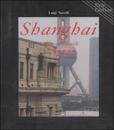上海建筑百年
出版时间:2008-6 出版社:上海教育出版社 作者:Luigi Novelli 页数:245
Tag标签:无
前言
This is the fourth edition of the Shanghai Architecture Guide to be publishedsince the first edition in 1999. In addition, I have published other guides whichconcentrate on residential and religious buildings. I started my research of thecity of Shanghai in 1997. My first visit to the city was in April 1992. At that time the city had notchanged much from it was in the 1930s and 1940s. Apart from the expansion ofthe city, few changes had occurred over the years. In 1992, Pudong was still afarmland. Only one bridge spanned the Huangpu River (the second one was atthat time under construction). The promenade as embankment along the Bund!Waitan was also under construction. No highway, subway or elevated-railwaycrossed the city. The Public Museum, the Public Library and the City Hall werestill in foreign (French or British) constructed buildings. Only a few high-risebuildings were evident in the city. Pudong airport was yet to be built and the citywas served by only one airport at Hongqiao. During the 1990s I witnessed the beginning of a large scale and rapidtransformation of the city. In just a few years, new public buildings had been builtwhich immediately became the new symbols of Shanghai: The Oriental Pearl TVTower, the Municipal Library, the City Hall, the Shanghai Museum, the GrandTheatre, and the Urban Planning Exhibition Centre. In addition, the citystransportation system was further developed, new bridges spanned the HuangpuRiver. Thousands of residential buildings were constructed as the city started toexpand towards the suburbs.
内容概要
《上海建筑百年(新版)》主要内容:This book is a short guide of architecture in Shanghai. The guide illustrates the architectural and urban landscape solely as an instant photograph and I have tried to refrain from including personal or general comments or opinions. As an architectural guide it contains illustrations of buildings, including photographs, drawings and indications of the location of buildings in the city. Furthermore, texts and photographs are explicative and unbiased in their content and significance. The guide is divided into six itineraries and each itinerary is divided into several sections, one for each building. Each section contains photographs, an exterior view as well as others to illustrate particular details or the interior view, a brief explanation, often a drawing and always the address in both English and Chinese. Each itinerary has a city map showing the location of the buildings illustrated.
作者简介
Luigi Novelli,Born in Rome, Italy. Graduated from the University of Rome No. I "La Sapienza" in 1987. Registered in the Architect Association of Rome. Since 1985 he had worked in Italy: mainly in Rome and central Italy (Abruzzo, Sardinia and Naples). During the early 1990s, he worked in Albania. He has engaged in new design, redevelopment, restorations, maintenance works, supervision of construction and interior design. Since 1997 he has worked in Shanghai and Beijing. He worked for four years in a Taiwanese architecture firm in Shanghai. Since 2003 he has worked in an Italian architecture firm based in Shanghai (projects in China mainland, Mongolia, Vietnam, Kazakhstan). He has worked on projects for new buildings, urban planning and interior design. He has published the books: - Shanghai Architecture between China and the West Dedalo Publishing House, Rome 1999 - Shanghai Architecture Gttide 100 Years/100 Buildings Baijia Publishing House, Shanghai 2001- Shan。ghai Architecture Gttide (two editions) - Shanghai Residential Buildings - Shanghai Religious Buildings Haiwen Audio-Visual Publishing, Shanghai 2003.
书籍目录
PrefaceAbout the BookShanghai: Urban Development and New ArchitectureItinerary 1Historical and Local HeritageItinerary2Modem and International HeritageItinerary 2A——Shanghai in the 1920sItinerary 2B——Shanghai in the 1930sItinerary 3Longtang (Shikumen) HousingItinerary 4Palmer & Turner Architecture and the Bund/WaitanItinerary 5Contemporary Shanghai:from the Late 1980s to 2007Itinerary 6Shanghai People's SquareAppendixAppendix l Three Generations of Public BuildingsAppendix 2 Wandering and Wondering aboutBund/Waitan and People's Square
章节摘录
Shanghai as a modern city was foundedduring the beginning and the middle of the19th century, however the pre-existing villageand temples were built in the region over thecenturies. Both village and temples are nowincorporated into the urban fabric. The pre-existing village had a circularlayout easily recognizable even now due tothe modern roads that follow that shape. It islocated in the southern part of downtownShanghai in the former Nanshi District, nowHuangpu District. A short stretch of the originaldefensive wall still exists in the museumof the former Temple of the God Guangong. Pre-existing temples and pagodas weredotted in many locations in the north, south,east and west. Some temples are still locatedin their original positions. Others were movedfrom their original sites to new ones. Sometemples still remain their original structureswhile others have been rebuilt with modern technologies. Given the above conditions, though Shanghai is not considered to be a "historicalcity" nowadays, its historical heritage isstrong and deeply rooted in the modern city. Due to the fact that historical heritagebuildings have been rebuilt, heavily renovatedand moved very frequently over the years,this guide illustrates buildings according tothe tocation criteria rather than chronologically.The title "Historical and Local Heritage"suggests that the two criteria cannot be takenin isolation of each other. Both historical andlocal terms are meaningful. The oldest settings among those includedin this guide are the Longhua Temple andLonghua Pagoda dating back t0 242 AD and247 AD respectively and the Jingan Templedating back t0 247 AD. However, the existingconstructions were rebuilt in 1899, 977 AD(although heavily restored in 1954) andapproximately the year 2000 (although stillunder construction) respectively.
图书封面
图书标签Tags
无
评论、评分、阅读与下载
用户评论 (总计1条)
- 大致翻了一下,每栋建筑所配的文字介绍较为简单,深度不够
